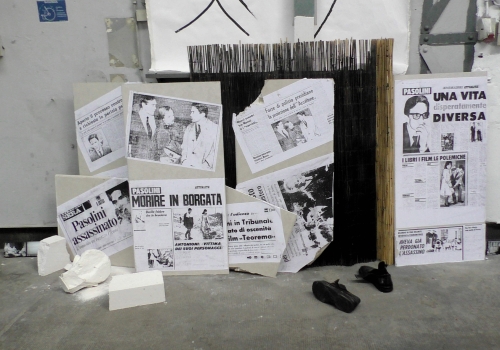| > back
Learn more about dance in Munich! In TTmag dance creators talk about their aesthetics and approach, dance formats and Munich dance topics are put under the microscope! |
 Conversations about pieces Micha Purucker: 100.80.40 - rats in the living room / études pathétiques Pier Paolo Pasolini, Derek Jarman, Rainer Werner Fassbinder, these three filmmakers determine the coordinates of your new work. In an interview with Katja Schneider, you mentioned these three, among other artists, as references for a certain kind of being-in-the-world... All three remained curious throughout their lives, overcame barriers, took an interest, got involved and exposed themselves. During their lifetime, they were severely assaulted for this, but they did not let this deter them. They were consistent in their stance as well as in their art: unbribable and incorruptible, each supported by a special .... yes, humanism: turned towards the people. You are a passionate cineaste and in your early days as a choreographer you once made a 40-minute film yourself, which I think was in fact invited to three film festivals. Film and dance – what do these arts have in common? There were many more films later on! Film lives from the movement of the camera, the actors; dance IS movement. I believe that these two spheres have more to do with each other in terms of reception aesthetics than dance and theatre, insofar as the latter continues to be text-based for the most part and out of tradition. Stage dance and film open up in the visual experience; it is about embodied perception, about resonance - about things before you have terms for them... Apart from the media and genre component, the translation of other artists' personalities through an artist - you're not doing this for the first time, you've already done works on Bacon (2008, "7 reece mews, London", Giacometti (2009 "echoes – 18 gestures in space"), Genet und Bowie (2018 "dark angels") - what appeals to you about it, or how do you start such an approach? I find it interesting to have references, relations, which are not developed textually, rather they are implicitly present, but can be named. There is a large reservoir of the known, the seen, the imagined, on which transmedial work is based, indeed which it presupposes. This creates comparability, but above all it articulates the differences between the individual media: film, image, music, sculpture, dance - and of course the differences in approaches and individual preferences, influences, themes, etc. The approaches are not academic and complete, of course; it can perhaps be described as empathetic and empathic, even though much and leg-hard research precedes and naturally flows in. It is a groping into another world.... You say quite clearly that one will look in vain for concrete parallels to the works of art or biographies of the artists, rather you are concerned with something common to the three that you think you see: a certain sensitivity, a special aesthetic, the way they deal with other people, the preference for certain artistic means. If I have understood correctly, the 'melodrama' would be a unifying constant and you also have "études pathétiques" in the title. Melodrama is a popular form of representation for conflicts of poor/rich, good/evil, young/old etc., which seeks the affective, the passionate and does not shy away from the touching. It achieves its special theatricality between artificiality and authenticity, and I think this is an element that can be found in all of them, as well as a pronounced awareness of form, the pastiche, the mix of different time levels and elements. All three artists are also iconic figures in the LGBTQ community, is that relevant to you when it comes to 'bringing it to the stage'? No, not at all. Because even as icons of the community, their gaze remains the gaze of outsiders. A view from the periphery of society, even if it focuses on the centre or is awarded prizes by the centre. That is what makes these works so interesting, that is why they see and show something different and in a different way than the majority society is used to and appreciates. As a member of a minority, you remain provisionally integrated at best, no matter what the community celebrates. And finally your title - you have already explained the number puzzle 100.80.40 - Pier Paolo Pasolini would have been one hundred years old in 2022, Derek Jarman eighty and Rainer Werner Fassbinder has now been dead for forty years - but "rats in the living room" what does that mean and where does it come from? The rat is more or less a pet, albeit a little loved one. It is considered a cultural follower, it's among humans, everywhere. t's among humans, everywhere. We keep them in our laboratories for experiments, we don't want them in the living room and you don't put clips in their hair. She is clever, eats everything, a persistent rodent .... "100.80.40 - rats in the living room / études pathétiques" takes place 12., 13. and 15. Januar 2023 at schwere reiter: INFO More about Micha Purucker: Website Micha Purucker The Interview was conducted by Simone Lutz, December 2022  Tanztendenz Munich e.V. is sponsored Tanztendenz Munich e.V. is sponsored by the Munich Department of Arts and Culture |
|||||
